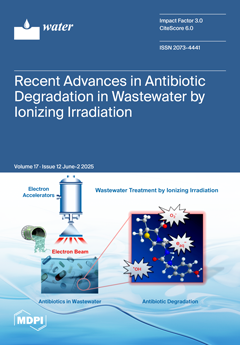A composite photocatalyst of ceria–cadmium supported on mesoporous SBA-15 silica was synthesized and employed for the aqueous methylene blue (MB) degradation. The composites were prepared using an incipient wetness impregnation technique and a conventional sol–gel approach with triblock copolymer P123 as a structure-directing agent for SBA-15 preparation, enabling the uniform dispersion of CeO
2 and Cd species within the SBA-15 framework. The physicochemical properties of both CeO
2/SBA-15 and Cd-CeO
2/SBA-15 composites were analyzed using small-angle and wide-angle XRD, FT-IR spectroscopy, SEM, TEM, EDX spectroscopy, N
2 physisorption at 77 K, and UV-Vis spectroscopy. The findings revealed that the SBA-15 support retained its well-ordered hexagonal mesostructure in both the ceria–SBA-15 and SBA-15-supported cadmium–ceria (Cd-CeO
2) composites. The highest degradation efficiency of 96.40% was achieved under optimal conditions, and kinetic analysis using the Langmuir–Hinshelwood model indicated that the MB degradation process followed pseudo-first-order kinetics, with a strong correlation coefficient (R
2 = 0.9925) and a rate constant (k) of 0.02532 min
−1. Under irradiation, the Cd-CeO
2/SBA-15 composites exhibited superior photocatalytic activity compared to the pristine components, owing to the synergistic interaction between ceria and cadmium, enhanced light absorption, and improved charge carrier separation. The recyclability test demonstrated that the degradation efficiency decreased slightly from 96.40% to 94.86% after three cycles, confirming the stability and reusability of Cd-CeO
2/SBA-15 composites. The photocatalytic process demonstrated a favorable electrical energy per order (EE/O) value of 281.8 kWh m
−3, indicating promising energy efficiency for practical wastewater treatment. These results highlight the excellent photocatalytic performance and durability of the synthesized Cd-CeO
2/SBA-15 composites, making them promising candidates for facilitating the photocatalytic decomposition of MB and other dye molecules in water treatment applications.
Full article





